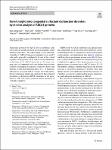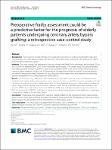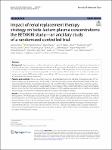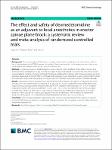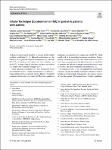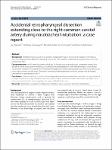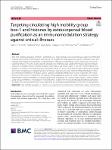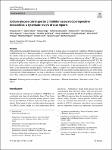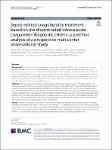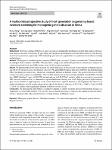Search
Author
- Osman, Ahmed I. (5)
- Daqing, Ma (3)
- Jorgensen, Ed (3)
- Li, Yan (3)
- next >
Subject
- kinh tế (26)
- Economics (12)
- programming (10)
- XRD (10)
- next >
Date issued
- 2020 - 2025 (2129)
- 2010 - 2019 (129)
- 2000 - 2009 (9)
- 1999 - 1999 (1)
Has File(s)
Search Results
Surfactants produced by type II alveolar epithelial cells (AT2 cells) are usually present in inclusion organelles called lamellar bodies (LBs). The ATP-binding cassette subfamily A member 3 (ABCA3) transporter primarily exists in AT2 cells and is generally considered to be one of the critical regulators of biogenesis of LBs and surfactant metabolism in the lungs [1,2,3,4]. ABCA3 mutations are the most common cause of congenital surfactant dysfunction disorders (CSDDs), resulting in fatal neonatal respiratory distress and pediatric or adult interstitial lung disease [3, 5,6,7]. |
Frailty has been considered to be associated with major mortality and increased length of stay after cardiac surgery. This study aimed to explore the predictive potential of frailty assessment in the prognosis of elderly patients undergoing bypass surgery. |
Sepsis prognosis correlates with antibiotic adequacy at the early phase. This adequacy is dependent on antibacterial spectrum, bacterial resistance profile and antibiotic dosage. Optimal efficacy of beta-lactams mandates concentrations above the minimal inhibitory concentration (MIC) of the targeted bacteria for the longest time possible over the day. Septic acute kidney injury (AKI) is the most common AKI syndrome in ICU and often mandates renal replacement therapy (RRT) initiation. Both severe AKI and RRT may increase outside target antibiotic concentrations and ultimately alter patient’s prognosis. |
Dexmedetomidine (DEX) has been thought to be an effective adjuvant to local anesthetics (LAs) in erector spinae plane block (ESPB), however, this method of use is not recorded in the drug instructions. Hence, our meta-analysis will evaluate its efficacy and safety for the first time. |
The InTeQ has proven to be feasible, valid, and reliable in adults with persistent asthma [16], which can be useful for patients’ self-monitoring and healthcare professionals teaching patients. This study aimed to assess the InTeQ’s validity and reliability in children and adolescents with asthma. This study was performed within the ARCA (Asthma Research in Children and Adolescents) cohort, a prospective, multicenter, observational study (NCT04480242) [17], replicating the original InTeQ validation performed on adults with asthma [16] |
Retropharyngeal dissection is a possible complication during nasotracheal intubation. We report a case of a retropharyngeal dissection extending close to the right common carotid artery occurring while inserting a nasotracheal tube. |
Both high mobility group box-1 (HMGB1) and histones are major damage-associated molecular patterns (DAPMs) that mediate lethal systemic inflammation, activation of the complement and coagulation system, endothelial injury and multiple organ dysfunction syndrome in critical illnesses. Although accumulating evidence collectively shows that targeting HMGB1 or histones by their specific antibodies or inhibitors could significantly mitigate aberrant immune responses in multiple critically ill animal models, routine clinical use of such agents is still not recommended by any guideline. |
Although the recommended preoperative cessation period for sodium-glucose cotransporter 2 inhibitors (SGLT2is) changed in 2020 (from 24 h to 3–4 days preoperatively) to reduce the risk of SGLT2i-associated perioperative ketoacidosis (SAPKA), the validity of the new recommendation has not been verified. Using case reports, we assessed the new recommendation effectiveness and extrapolated precipitating factors for SAPKA. We searched electronic databases up to June 1, 2022 to assess SAPKA (blood pH < 7.3 and blood or urine ketone positivity within 30 days postoperatively in patients taking SGLT2i). |
The development of disseminated intravascular coagulation (DIC) in patients with sepsis has been repeatedly confirmed as a factor associated with poor prognosis. Anticoagulant therapy has been expected to improve sepsis patient outcomes, whereas no randomized controlled trials have demonstrated the survival benefit of anticoagulant therapies in non-specific overall sepsis. Patient selection based on the component of “high disease severity” in addition to “sepsis with DIC” has recently proved important in identifying appropriate targets for anticoagulant therapy. The aims of this study were to characterize “severe” sepsis DIC patients and to identify the patient population benefiting from anticoagulant therapy. |
Newborn screening (NBS) is an important and successful public health program that helps improve the long-term clinical outcomes of newborns by providing early diagnosis and treatment of certain inborn diseases. The development of next-generation sequencing (NGS) technology provides new opportunities to expand current newborn screening methodologies. |

